
The Ninth Fort is a stronghold in the northern part of Šilainiai elderate, Kaunas, Lithuania. It is a part of the Kaunas Fortress, built in the late 19th century. During the Soviet occupation, the fort was used as a prison and way-station for prisoners being transported to labour camps. After the occupation of Lithuania by Nazi Germany, the fort was used as a place of execution for Jews, captured Soviets, and others.
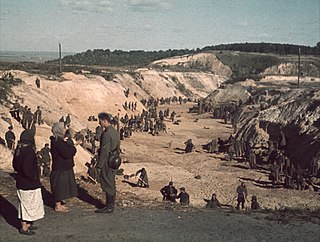
Babi Yar or Babyn Yar is a ravine in the Ukrainian capital Kyiv and a site of massacres carried out by Nazi Germany's forces during its campaign against the Soviet Union in World War II. The first and best documented of the massacres took place on 29–30 September 1941, in which some 33,771 Jews were murdered. Other victims of massacres at the site included Soviet prisoners of war, communists and Romani people. It is estimated that a total of between 100,000 and 150,000 people were murdered at Babi Yar during the German occupation.

Jasenovac was a concentration and extermination camp established in the village of the same name by the authorities of the Independent State of Croatia (NDH) in occupied Yugoslavia during World War II. The concentration camp, one of the ten largest in Europe, was established and operated by the governing Ustaše regime, Europe's only Nazi collaborationist regime that operated its own extermination camps, for Serbs, Romani, Jews, and political dissidents. It quickly grew into the third largest concentration camp in Europe.
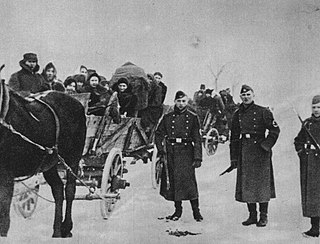
Belzec was a Nazi German extermination camp in occupied Poland. It was built by the SS for the purpose of implementing the secretive Operation Reinhard, the plan to murder all Polish Jews, a major part of the "Final Solution", the overall Nazi effort to complete the genocide of all European Jews. Before Germany's defeat put an end to this project more than six million Jews had been murdered in the Holocaust. The camp operated from 17 March 1942 to the end of June 1943. It was situated about 500 m (1,600 ft) south of the local railroad station of Bełżec, in the new Lublin District of the General Government territory of German-occupied Poland. The burning of exhumed corpses on five open-air grids and bone crushing continued until March 1943.

The Dasht-i-Leili massacre occurred in December 2001 during the U.S. invasion of Afghanistan when 250 to 2,000 Taliban prisoners were shot and/or suffocated to death in metal shipping containers while being transferred by Junbish-i Milli soldiers under the supervision of forces loyal to General Rashid Dostum from Kunduz to Sheberghan prison in Afghanistan. The site of the graves is believed to be in the Dasht-e Leili desert just west of Sheberghan, in the Jowzjan Province.

Hans Kammler was an SS-Obergruppenführer responsible for Nazi civil engineering projects and its top secret V-weapons program. He oversaw the construction of various Nazi concentration camps before being put in charge of the V-2 rocket and Emergency Fighter Programs towards the end of World War II. Kammler disappeared in May 1945 during the final days of the war. There has been much conjecture regarding his fate.

The NKVD prisoner massacres were a series of mass executions of political prisoners carried out by the NKVD, the People's Commissariat for Internal Affairs of the Soviet Union, across Eastern Europe, primarily in Poland, Ukraine, the Baltic states and Bessarabia. After the start of the German invasion of the Soviet Union on June 22, 1941, NKVD troops were supposed to evacuate political prisoners to the interior of the Soviet Union, but the hasty retreat of the Red Army, a lack of transportation and other supplies, and general disregard for legal procedures often led to prisoners being simply executed.

The Bleiburg repatriations were a series of forced repatriations from Allied-occupied Austria of Axis-affiliated individuals to Yugoslavia in May 1945 after the end of World War II in Europe. During World War II, Yugoslavian territory was either annexed or occupied by Axis forces, and as the war came to end, thousands of Axis soldiers and civilian collaborators fled Yugoslavia for Austria as the Yugoslav Army (JA) gradually retook control. When they reached Austria, in accordance with Allied policy, British forces refused to take them into custody and directed them to surrender to the JA instead. The JA subsequently subjected them to death marches back to Yugoslavia, where those who survived were either subject to summary executions or interned in labor camps, where many died due to harsh conditions. The repatriations are named for the Carinthian town of Bleiburg, where the initial British refusal to accept the surrenders occurred, and from which some repatriations were carried out.
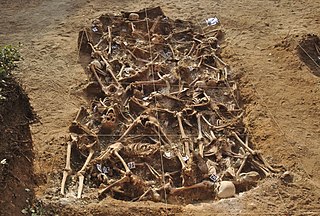
A mass grave is a grave containing multiple human corpses, which may or may not be identified prior to burial. The United Nations has defined a criminal mass grave as a burial site containing three or more victims of execution, although an exact definition is not unanimously agreed upon. Mass graves are usually created after many people die or are killed, and there is a desire to bury the corpses quickly for sanitation concerns. Although mass graves can be used during major conflicts such as war and crime, in modern times they may be used after a famine, epidemic, or natural disaster. In disasters, mass graves are used for infection and disease control. In such cases, there is often a breakdown of the social infrastructure that would enable proper identification and disposal of individual bodies.

Afghan Massacre: The Convoy of Death is a 2002 documentary by Irish filmmaker Jamie Doran and Afghan journalist Najibullah Quraishi. It documents alleged war crimes committed by the Junbish-i Milli faction of the Afghan Northern Alliance under General Abdul Rashid Dostum against Taliban fighters. The Taliban fighters, who had surrendered to Dostum's troops after the November 2001 siege of Kunduz, were transported to Sheberghan prison in sealed containers. Human rights groups estimate that hundreds or thousands of them died during and after transit. Afghan Massacre: The Convoy of Death presents testimony from interviewees stating that American military personnel were present at and complicit in some of the mass killings, known as the Dasht-i-Leili massacre.

Dem'ianiv Laz is a mass burial site of victims of the Soviet extrajudicial killings committed following the Soviet invasion of Poland near Stanisławów. At least 524 captives were shot by the NKVD and buried in several mass graves dug by the prisoners themselves in a small gorge outside of the city.

The Bykivnia graves are a National Historic Memorial next to the former village of Bykivnia within Kyiv woodland, Bykivnia Forest. During the Stalinist period in the Soviet Union, it was one of the unmarked mass grave sites where the NKVD, the Soviet secret police, disposed of thousands of executed "enemies of the Soviet state".
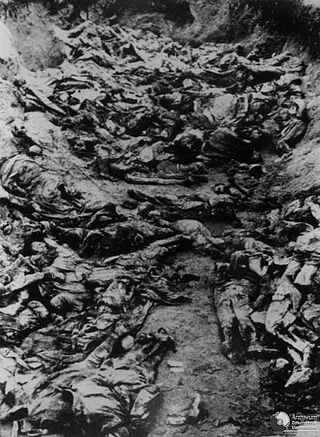
The Katyn massacre was a series of mass executions of nearly 22,000 Polish military officers and intelligentsia prisoners of war carried out by the Soviet Union, specifically the NKVD in April and May 1940. Though the killings also occurred in the Kalinin and Kharkiv prisons and elsewhere, the massacre is named after the Katyn forest, where some of the mass graves were first discovered by German Nazi forces.

The Soldau concentration camp established by Nazi Germany during World War II was a concentration camp for Polish and Jewish prisoners. It was located in Działdowo, a town in north-eastern Poland, which after the Nazi-Soviet invasion of Poland in September 1939 was annexed into the Province of East Prussia.

Hinzert concentration camp was a concentration camp in Nazi Germany, in what is now Rhineland-Palatinate, 30 kilometres (19 mi) from the border with Luxembourg. Between 1939 and 1945, 13,600 political prisoners between the ages of 13 and 80 were imprisoned at Hinzert. Many were in transit towards larger concentration camps where most would be killed. However, many prisoners were executed at Hinzert. The camp was administered, run, and guarded mainly by the SS, who, according to survivors, were notorious for their brutality and viciousness.
The massacres in Piaśnica were a series of mass murders carried out by Nazi Germany during World War II, between the fall of 1939 and spring of 1940 in Piaśnica Wielka in the Darzlubska Wilderness near Wejherowo. The exact number of people murdered is unknown, but estimates range between 12,000 and 14,000 victims. Most of them were Polish intellectuals from Gdańsk Pomerania, but Poles, Kashubians, Jews, Czechs and German inmates from mental hospitals from the General Government and the Third Reich were also murdered. After the Stutthof concentration camp, Piaśnica was the largest site of killings of Polish civilians in Pomerania by the Germans, and for this reason, is sometimes referred to as the "second" or "Pomeranian" Katyn. It was the first large-scale Nazi atrocity in occupied Poland.

Abu Salim prison is a maximum security prison in Tripoli, Libya. The prison was notorious during the rule of Muammar Gaddafi for alleged mistreatment and human rights abuses, including a massacre in 1996 in which Human Rights Watch estimated that 1,270 prisoners were killed.

The Sobibór Museum or the Museum of the Former Sobibór Nazi Death Camp, is a Polish state-owned museum devoted to remembering the atrocities committed at the former Sobibor extermination camp located on the outskirts of Sobibór near Lublin. The Nazi German death camp was set up in occupied Poland during World War II, as part of the Jewish extermination program known as the Operation Reinhard, which marked the most deadly phase of the Holocaust in Poland. The camp was run by the SS Sonderkommando Sobibor headed by Franz Stangl. The number of Jews from Poland and elsewhere who were gassed and cremated there between April 1942 and October 14, 1943 is estimated at 250,000; possibly more, including those who came from other Reich-occupied countries.
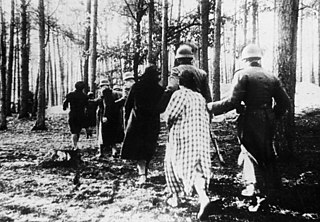
The Palmiry massacre was a series of mass executions carried out by Nazi German forces, during World War II, near the village of Palmiry in the Kampinos Forest northwest of Warsaw.

The Tarnopol Ghetto was a Jewish World War II ghetto established in 1941 by the Schutzstaffel (SS) in the prewar Polish city of Tarnopol.






















